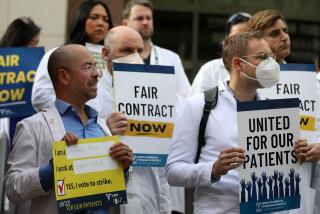Nurses Strike Spreading in L.A., but Few Patients Moved to Orange County
- Share via
Labor unrest in Los Angeles County’s sprawling public health care system spread Thursday as X-ray technicians walked out in support of hundreds of striking nurses, and resident physicians at the 1,445-bed County-USC Medical Center threatened to “shut down the hospital” by staging their own strike this morning.
In a severe curtailment of emergency service, the County-USC trauma center and emergency room, which typically treats almost 600 patients a day, was closed to all ambulance traffic. Officials decided to close the trauma center Thursday morning when eight of the 10 radiologic technicians scheduled to work failed to report, said Richard Cordova, General Hospital administrator.
Selective Acceptance
Other county hospitals continued to accept some ambulance traffic but turned aside all but the most critical patients.
Nurse absenteeism held steady at 59% at the six public hospitals during the third day of the strike, county officials said. Abby Haight, spokeswoman for Local 660 of the Service Employees International Union, AFL-CIO, which represents 4,000 county nurses, claimed 80% of the nurses boycotted.
The radiologic technicians who struck Thursday are few in number but virtually impossible to replace on short notice. So the failure of eight of 10 to show for work at County-USC virtually closed the emergency room. Harbor-UCLA Medical Center reported that two of the three scheduled there failed to show for work. At Martin Luther King Jr./Drew Medical Center in South-Central Los Angeles, there was 50% absenteeism.
Contract Dispute
For the radiologic technicians who walked off the job Thursday, the dispute centers on a contract negotiated with the county by Local 434 of the Service Employees International Union. The contract provides an 8.5% wage increase over two years.
Hospital administrators attempted to cope with the shortage of nurses and technicians by assigning double or triple shifts to the staff members still on duty and by continuing to shrink their patient load by transferring patients to private facilities, refusing most new entrants and postponing elective surgery. Most outpatient clinics also remained closed, except for critical services like chemotherapy.
Many patients who were sick but in stable condition continued to be transferred to private hospitals, but assistant health director Irv Cohen said transfers slowed considerably, indicating that local private hospitals may be reaching capacity.
Doctors May Picket
As a result, he said, hospital administrators are eyeing beds as far away as Kern County and San Diego. “We’ll go as far as necessary,” he said.
Since the strike began, six infants from Los Angeles County have been transferred to the neonatal care unit at Childrens Hospital of Orange County, officials at the hospital in Orange said.
But officials at other Orange County hospitals, many of which are privately run, reported few, if any, patient transfers from Los Angeles County.
At a meeting Wednesday in Anaheim, Orange County representatives of the Hospital Council of Southern California discussed the potential impact of the nurses strike, said Jon Gilwee, regional director of the council.
Gilwee said two things would have to happen before patients could be accepted at Orange County’s private hospitals. Los Angeles County and a private hospital would have to agree on the payment, and the hospital’s doctors would have to agree to accept the additional patients.
“Our area is served by private physicians,” Gilwee said. “They’re probably not too excited about helping L.A. County with their problems. There are just no available sources of physicians.”
Cordova said that the danger ahead is that only the most critically ill patients will be left at Los Angeles’ county hospitals--those with AIDS, severe burns and with acute respiratory problems, for example.
The situation could worsen today. The Joint Council of Interns and Residents, which represents about 1,500 doctors, voted to send 800 resident physicians out of the hospitals and onto the picket lines at 7 a.m today if last-minute labor talks cannot break deadlocked negotiations.
Mark Segal, a director of the Joint Council, said a big walkout by residents would “effectively shut down the hospital.”
But Robert Gates, director of the county’s Department of Health Services, said that if the residents strike, “We would have an increasingly critical situation . . . but it does not mean we would have to close a hospital.”
Dr. Sol Bernstein, medical director at County-USC Medical Center, said the 300 faculty physicians, who usually supervise resident physicians, will pitch in and provide hands-on patient care typically given by the residents.
“The only thing they are probably not as good at as the residents is working long hours and staying up in the middle of the night,” Bernstein said.
Residents are doctors who have graduated from medical school and are receiving four years of training in a hospital under the supervision of senior physicians. Interns are first-year residents.
Contributing to this story were Times staff writers Gerald Faris, Paul Feldman, John Hurst, Louis Sahagun, Brenda Paik Sunoo.
More to Read
Sign up for Essential California
The most important California stories and recommendations in your inbox every morning.
You may occasionally receive promotional content from the Los Angeles Times.













